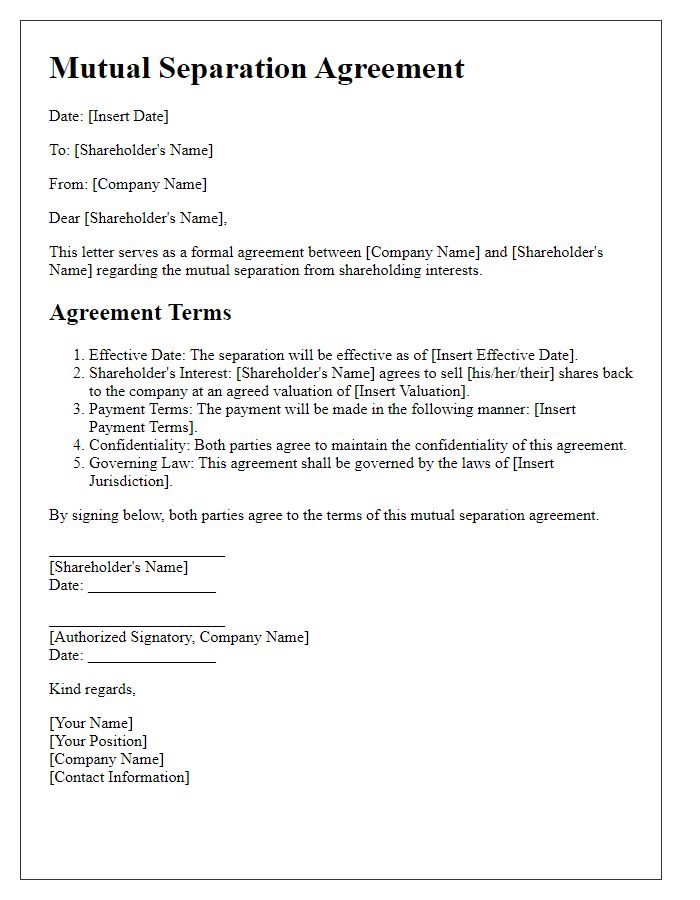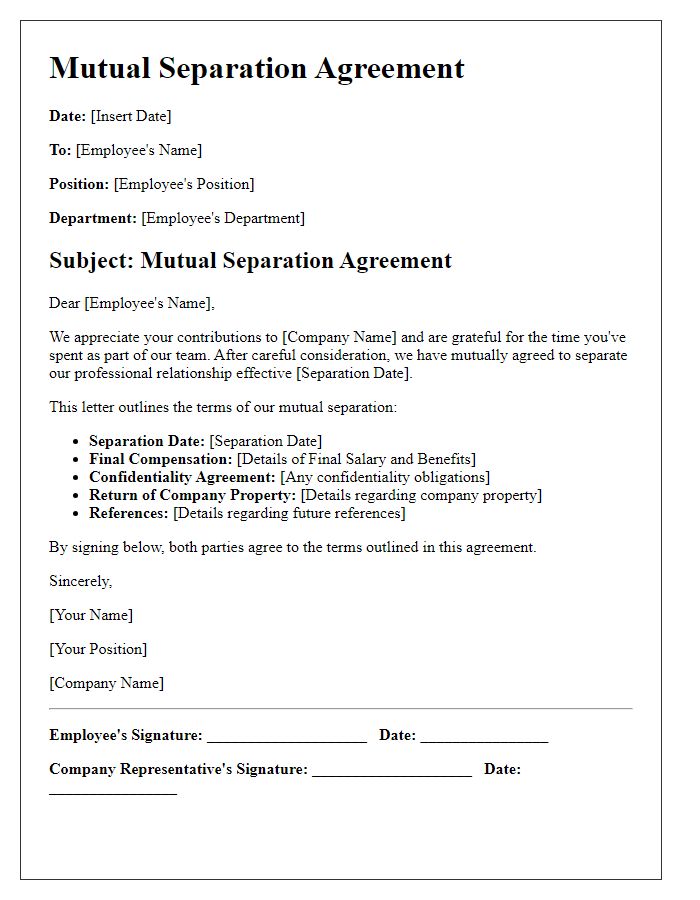Are you considering a mutual separation agreement but feeling a bit overwhelmed about where to start? Crafting the right letter can set a positive tone for the process, ensuring that both parties feel respected and understood. In this article, we'll guide you through a clear and concise letter template designed specifically for mutual separation agreements. Read on to discover the best way to express your intentions and make this transition smoother for everyone involved!

Clearly Defined Terms & Conditions
A mutual separation agreement outlines the terms and conditions under which two parties, such as an employer and employee, agree to part ways amicably. Key components include the effective date of separation, typically marked by the last working day, and the financial settlement details, which may involve severance pay or entitlements like unused vacation days or bonuses. Confidentiality clauses are often included, prohibiting either party from discussing the terms of the agreement publicly. Additionally, the agreement may stipulate the return of company property and the provision of references. Legal considerations, such as compliance with labor laws and regulations applicable in the jurisdiction, are also crucial, ensuring that both parties understand their rights and obligations. Effective communication throughout the process can foster a positive atmosphere, maintaining professional relationships for potential future interactions.
Mutual Release of Claims
A mutual release of claims agreement serves as a formal document outlining the terms under which two parties, often previous business partners or employees, agree to release each other from potential legal claims and liabilities. Such agreements typically include details about the effective date, parties involved, and any specific claims being waived. In many cases, this can include any disputes arising from employment agreements, partnership contracts, or other interactions. Legal terms such as "indemnification" and "arbitration clauses" may be present to prevent future legal actions and ensure that both parties have agreed to resolve any issues amicably. A clear outline of any financial settlements or obligations can also be a key component of this document, protecting both parties from future financial disputes. Notably, the jurisdiction and governing law, which denote which court's laws will oversee the agreement, are critical aspects often specified at the end of such contracts.
Confidentiality Clause
A confidentiality clause in a mutual separation agreement ensures that both parties, typically employees and employers, commit to keeping sensitive information private. This clause outlines specific nondisclosure obligations regarding proprietary company information, trade secrets, and personal information (such as compensation or personal evaluations). Violations may lead to legal consequences, illustrating the importance of maintaining confidentiality in sensitive matters. Additionally, the clause often specifies the duration of confidentiality obligations, which might extend indefinitely, underscoring the significance of trust and discretion even after the separation. The importance of this clause cannot be understated, as it protects the interests of both the individual and the organization involved, fostering a respectful disengagement process.
Non-Disparagement Agreement
A mutually agreed separation agreement can provide a framework for the departure of an employee from a company, including clauses related to non-disparagement. Non-disparagement agreements aim to protect the reputation and interests of both parties involved. Such agreements often stipulate that parties will refrain from making any negative statements about each other, whether through verbal communication or written mediums, which could harm reputations or business interests. These clauses might also include specific conditions under which such statements can be made, such as legal proceedings or required disclosures. The effectiveness of these agreements can vary based on jurisdiction and enforcement practices, as different states have distinct laws regarding employment and contractual obligations.
Final Settlement Amount
A mutual separation agreement outlines terms and conditions when both parties agree to part ways amicably. A crucial aspect includes the final settlement amount, representing the total financial compensation to be exchanged during the separation process. This amount often considers factors such as unpaid wages, accrued vacation days, severance pay, and any other compensation owed to the departing party. It is important for the settlement to comply with local labor laws, which vary by region, including specific statutes that govern termination benefits. Additionally, the date of final payment, typically agreed upon before departure, establishes clarity for both parties involved in the separation and ensures a smoother transition.













Comments